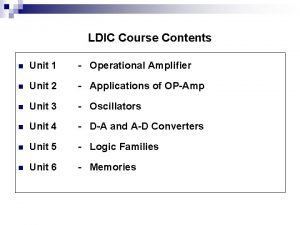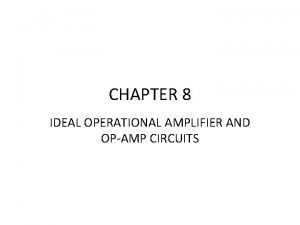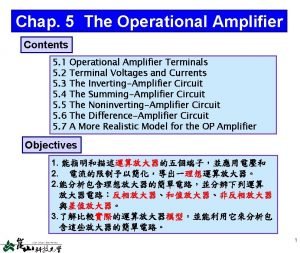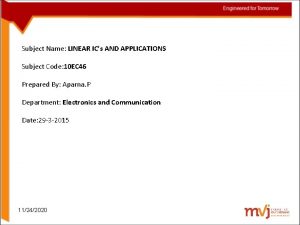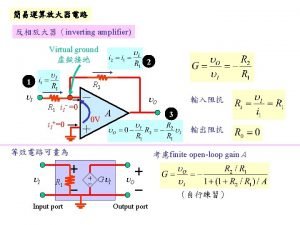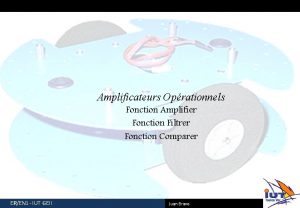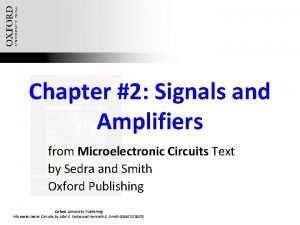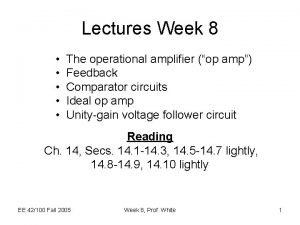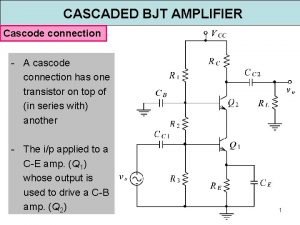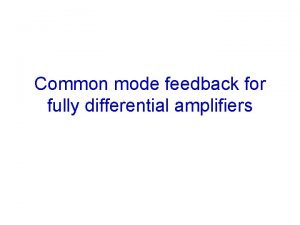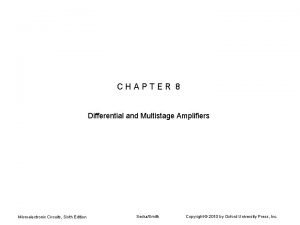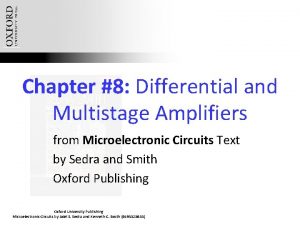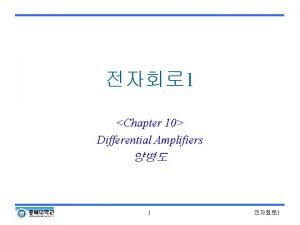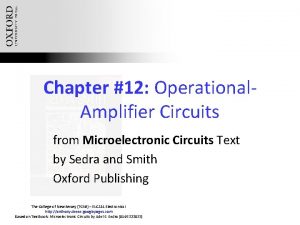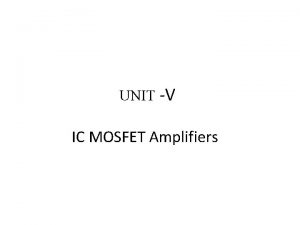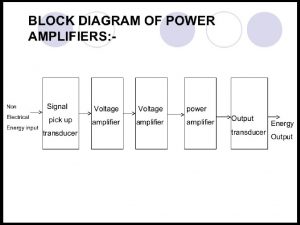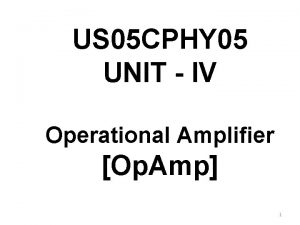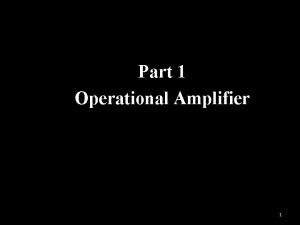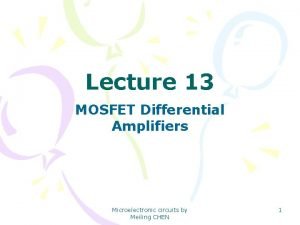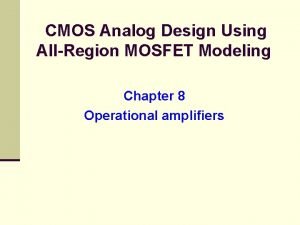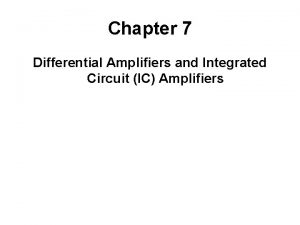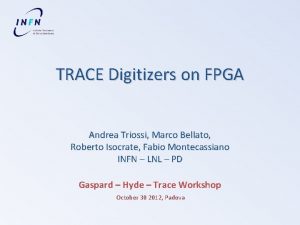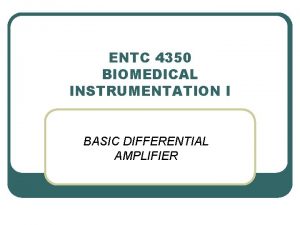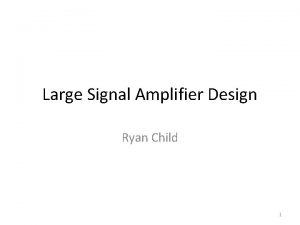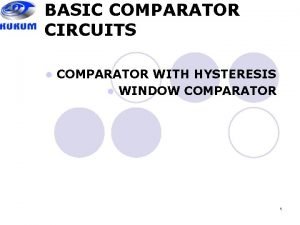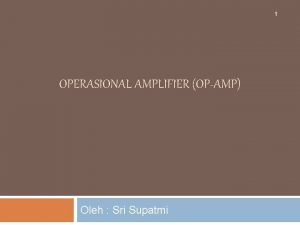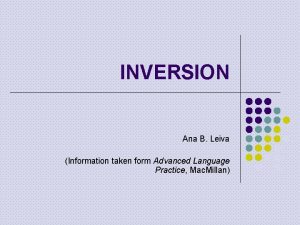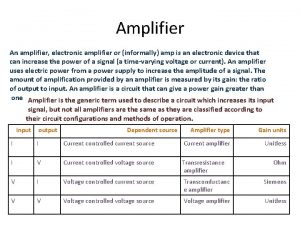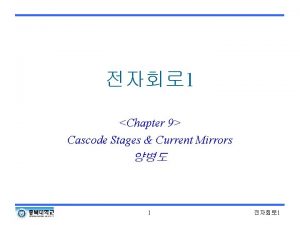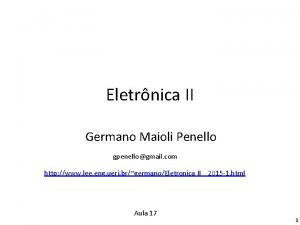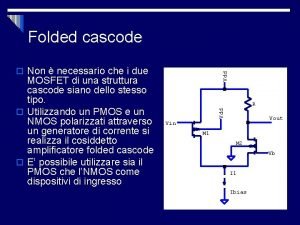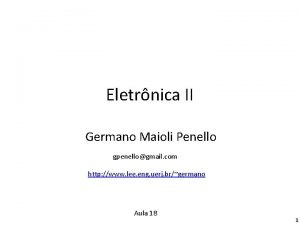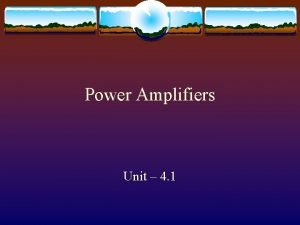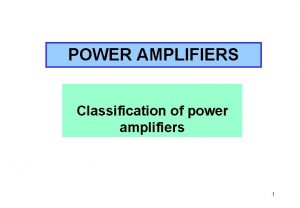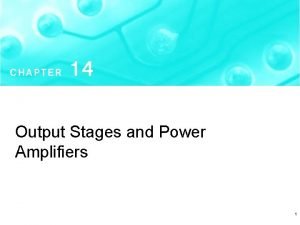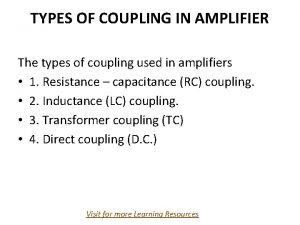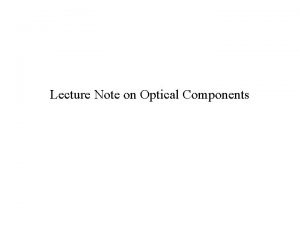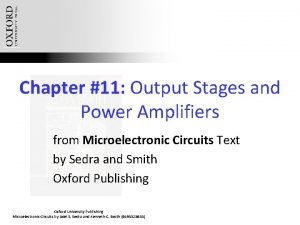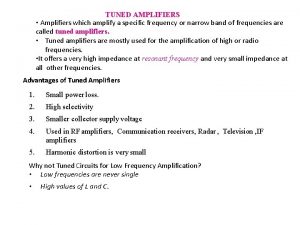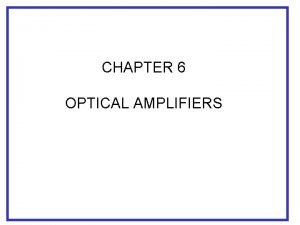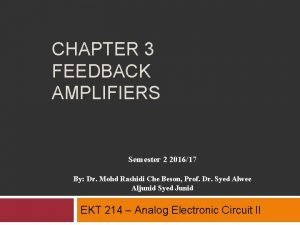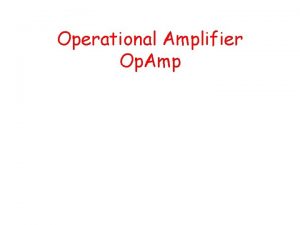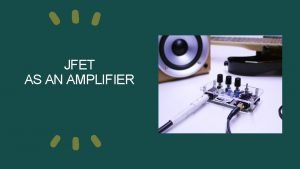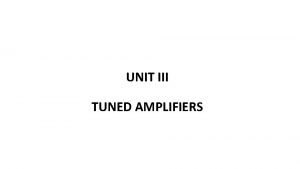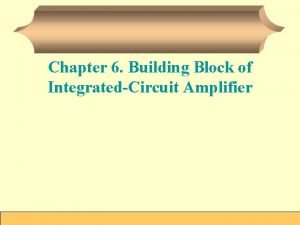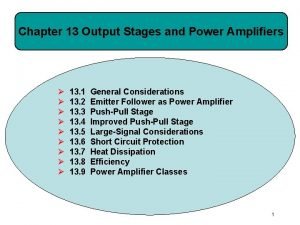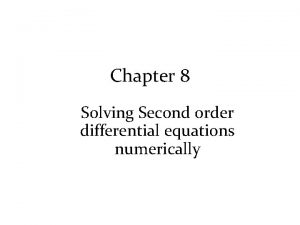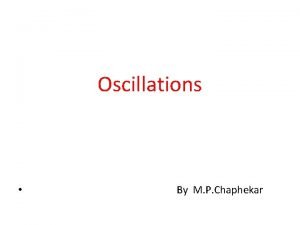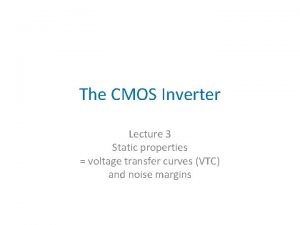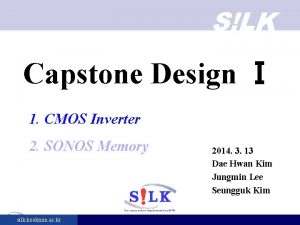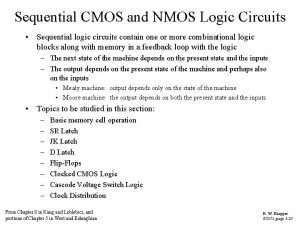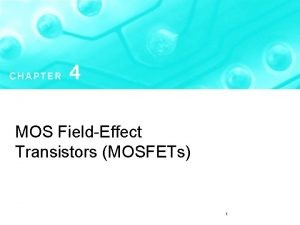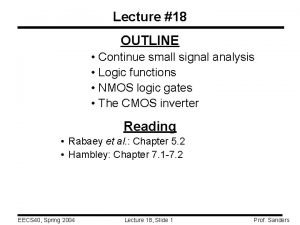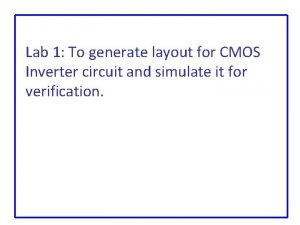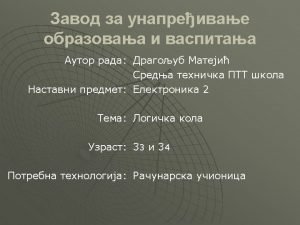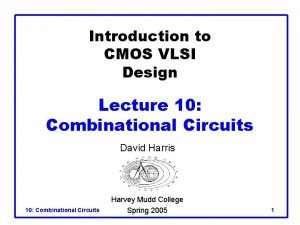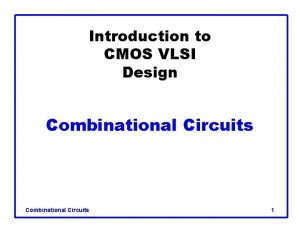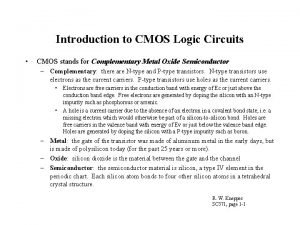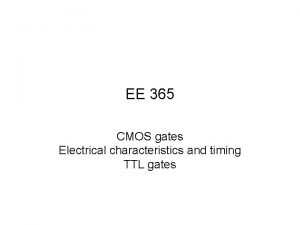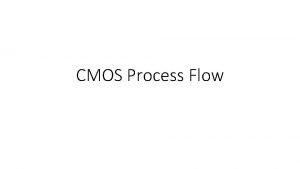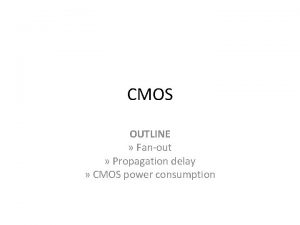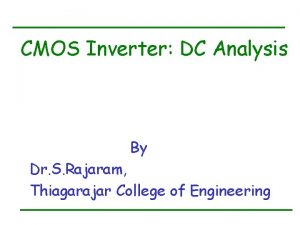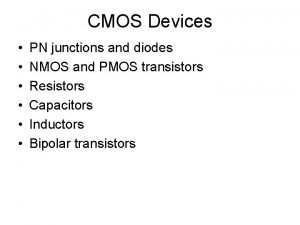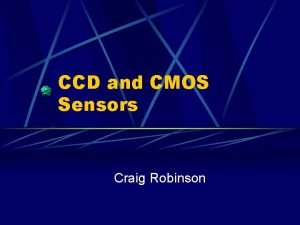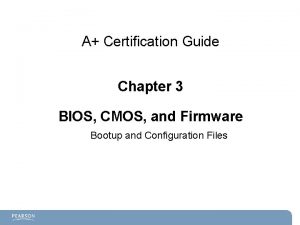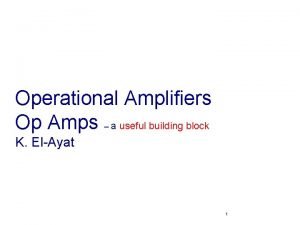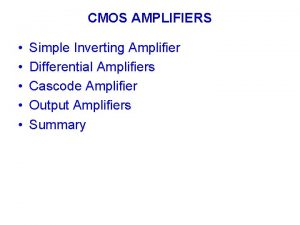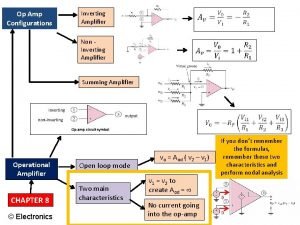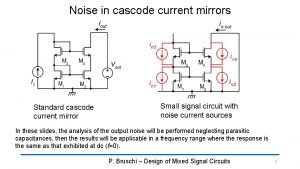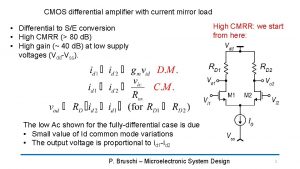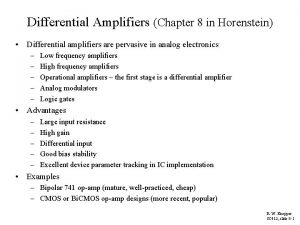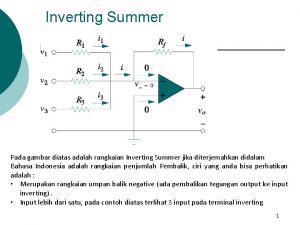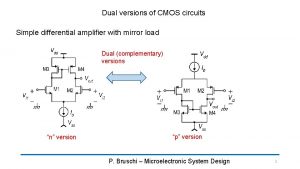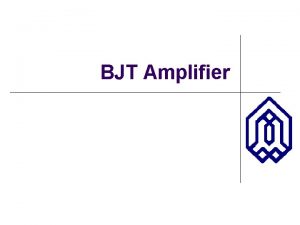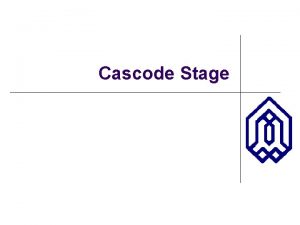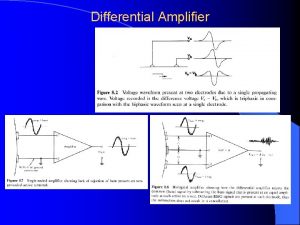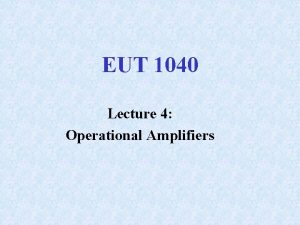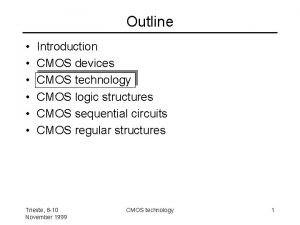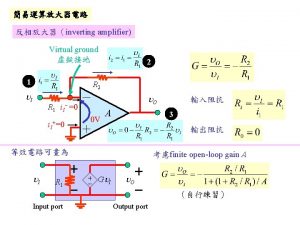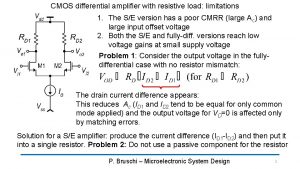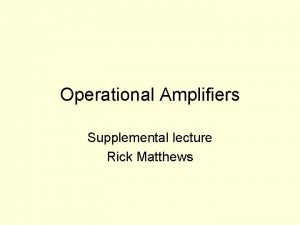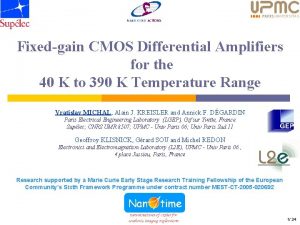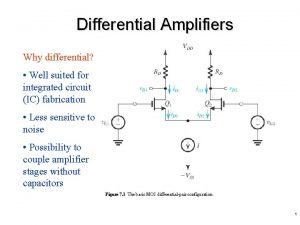CMOS AMPLIFIERS Simple Inverting Amplifier Differential Amplifiers Cascode























































































- Slides: 87

CMOS AMPLIFIERS • • • Simple Inverting Amplifier Differential Amplifiers Cascode Amplifier Output Amplifiers Summary

Simple Inverting Amplifiers

Inverter with diode connection load Small Signal Characteristics How do you get better matching?

High gain inverters

Current source load or push-pull • Refer to book for large signal analysis • Must match quiescent currents in PMOS and NMOS transistors • Wider output swing, especially push-pull • Much high gain (at DC), but much lower 3 d. B frequency (vs diode load) • About the same GB • Very power dependent

Small signal High gain!

Key to analysis by hand: • Use level 1 or 3 model equations • Use KCL/KVL


Dependence of Gain upon Bias Current

Transfer function of a system input u System output y

When u(s) = 0, y(s) satisfies: These dynamics are the characteristic dynamics of the system. The roots of the coefficient polynomial are the poles of the system. When y(s) = 0, u(s) satisfies: These dynamics are the zero dynamics of the system. The roots of the coefficient polynomial are the zeros of the system.

Frequency Response of CMOS Inverters

Poles of CMOS Inverters Let vin = 0, x = 0, VDD = 0, VSS = 0. y CGS 1, CGS 2, CBS 1, CBS 2 are all short CGD 1, CGD 2, CBD 1, CBD 2, CL in parallel C’L = Ctotal = CGD 1+ CGD 2+ CBD 1+ CBD 2+ CL

Total conductance from y to ground: go = gds 1 + gds 2 KCL at node y: Therefore system pole is:

Zeros of CMOS Inverters Let vin = x = u, VDD = 0, VSS = 0. CGD 1, CGD 2, are in parallel, CBD 1, CBD 2, CL are all short gds 1, gds 2 also short No current in them KCL: Zero is:

Input output transfer function When s=jw 0, A(0) When w ∞, A(s)

A 0=gm/go Acl=1/b 0 d. B |p 1|= g 0/CL’ Unity gain frequency =|A 0 p 1| =GB =gm/CL’ -3 d. B frequency of closed loop =b*GB |z 1| =gm/Cgd =GB*CL’/Cgd

Unity gain feedback A(s)

If a step input is given, the output response is In the time domain: Final settling determined by A 0 need high gain Settling speed determined by A 0 p 1=GB, need high gain bandwidth product

Gain bandwidth product C’L = Ctotal = CGD 1+ CGD 2+ CBD 1+ CBD 2+ CL When CL ≈ C’L, W↑ GB↑, but it saturates, when

Note: If VEB 1 and VEB 2 are fixed, W 1/L 1 and W 2/L 2 must be adjusted proportionally, and they are proportional to DC power.

Therefore: P is proportional to W 1, W 2 CL constant, but C(W 1, W 2) proportional to W 1, W 2 When C(W 1, W 2) << CL, GB proportional to P When C(W 1, W 2) CL or >CL, GB saturates

GB Linear increase region P

NOISE IN MOS INVERTERS

For 1/f noise:

For thermal noise

Noise in Push-Pull current source load Inverter

Differential Input, single-ended output single stage Amplifier N-Channel vin+ vin-

P-channel

Large Signal Eq. in a N-channel Differential pair =0. 5 b 1(VGS 1 -VT)2 =(2 ID 1/b 1)0. 5 i. D 1=0, when i. D 2=ISS and VGS 2=VT+(2 ISS/b)0. 5


Solving for i. D 1 and i. D 2 i. D 1=i. D 2=ISS/2 VON 1=VON 2=(ISS/b)0. 5

N-Channel Input Pair Differential Amplifier C. M. Load Simple current reference C. M. Bias

Voltage transfer curve

P-Channel Input Pair Differential Amplifier

Voltage transfer curve

INPUT COMMON MODE RANGE VG 1=VG 2=Vi. CM VSDSAT 1=VSDSAT 2 =VON VD 1=VD 3= VSS+VT 3+VON VG 1 min=VD 1 -|VT 1| VG 1 max=VDDVSD 5 SAT-|VT 1|-VON

Output Range Vomin=Vss+Von 4 Vomax=Vicm –|VT 2| So what’s the vo range What’s for the N-ch circuit.

SMALL SIGNAL ANALYSIS AV

Common Mode Equivalent Circuit, with perfect match i. C 1=VIC/(1/gm 1 +2 rds 5) ro 1≈1/gm 3 i. C 1 ACM≈ 1/ 2 rds 5 gm 3 CMRR=Av/ACM=2 gm 1 gm 3/(gds 4+gds 2)/gds 5

If not perfectly matched io=ai. IC a is a fraction go 1≈ gds 2 + gds 4 i. C 1 ACM≈ agds 5 / 2(gds 2 + gds 4) CMRR=Av/ACM=2 gm 1/agds 5

Formal detailed analysis




SLEW RATE: the limit of the rate of change of the output voltage C’Ldvo/dt=i 4 -i 2 ISS Max |CLdvo/dt|=ISS Slew Rate = ISS/C’L ISS 0 Output swing: Vosw GB frequency: f. GB vo(t)=Voswsin(2 pf. GBt) Max dvo/dt =Vosw 2 pf. GB To avoid slewing: ISS > C’L Vosw 2 pf. GB

Parasitic Capacitances CT: common mode only CM: mirror cap = Cdg 1 + Cdb 1 + Cgs 3 + Cgs 4 + Cdb 3 COUT = output cap = Cbd 4 + Cbd 2 + Cgd 2 + CL

• Impedances – rout = rsd 2 || rds 4 = 1 / (gds 2 + gds 4) – r. M = 1/gm 3 || rds 1 ≈ 1/ gm 3 – Hence the output node is the high impedance node • When vi=0, slowest discharging node is output node with dominant pole p 1 = -1/(C’outrout), where C’out = Cout+ Cgd 4 • Approximate transfer function AV(s) = AV/(s/p 1─1)

When v. G 1=v. G 2=0(AC) KCL at D 1: KCL at D 2:

Gain bandwidth product • • Gain AV(0) = gm 1 / (gds 2 + gds 4) Bandwidth ≈ |p 1| ≈ (gds 2 + gds 4) / C’out GBW ≈ gm 1 / C’out gm 1 = {2*ID 1 m. Cox. W 1/L 1}½ – increase gm 1 increase GBW – increase W 1 increase GBW • But C’out has Cdb 2 and Cgd 2 W 1 – Once Cdb 2 and Cgd 2 become comparable to CL, increasing W 1 reduces GBW

Other poles and zeros VDD Second pole at D 1 M 4 r = 1/gm 3 Cgd 4 C = CM + M 3 (1+AV 4)Cgd 4 Vi+ M 1 Vb 2 M 5 VOUT Cgd 4 (1+AV 4)Cgd 4 CL AV 4 = gm 4/gds 4 Vi- p 2 = ─ gm 3 CM + (1+AV 4)Cgd 4

VDD M 3 Unstable zero at Cgd 2 Enforce vo=0, float vin. M 4 ids 2, ids 4 = 0 VOUT CL Vi+ = - Vi- M 1 Vb 2 M 5 Vi- Cgd 2 dvi-/dt = gm 2 viz 1 = gm 2/Cgd 2

VDD For zero at D 1: M 3 For diff, Vi+ = - Viwhich is set by Cgd 2 M 4 VOUT CL Vi+ M 1 M 2 Vi- z 2 = Vb 2 M 5 Both Cgd 4 and Cgd 1 to gnd Ctot = CM + Cgd 4 ─gm 3 CM + Cgd 4

• A better approximation of TF: AV(s)=AV(s/z 1 -1)(s/z 2 -1)/(s/p 1 -1)(s/p 2 -1) • If p 1 is dominant, |p 1|<<|p 2|, |z 1|, |z 2|; AV(s)≈AV/(s/p 1 -1) • If p 1 is non-dominant, at low frequency, AV(s)≈AV /(s/p 1+s/p 2 -s/z 1 -s/z 2 -1) • 1/peq≈ 1/p 1+1/p 2 -1/z 1 -1/z 2 ≈ 1/p 1+1/p 2 -1/z 2 , since |z 1| >> |z 2|, |p 1|, |p 2|; ≈ 1/p 1, if AV 4 is not very large • In either case, BW ≈ p 1

frequency response AV All in abs val z 1 p 2 z 2 UGF -90 -180 PM w

Observations • PM ≈ 90 – tan-1(UGF/z 1) § GBW should be at least 2~3 times lower than z 1 to ensure good phase margin at UGF § There is conflict between AV and PM • If z 2 not = p 2, UGF < AV*p 1 • Design approaches • make z 1 higher than UGF • make Cgd 2 small, gm 1 large • make z 2 close to p 2 better 1 st order approx. • make AV 4 small • make p 1 low large AV • make gds 2 and gds 4 small

Design Steps • Select Iss based on – GB & V_osw, SR, or P_max • Select W 1/L 1 based on – GB = gm/CL’, Assuming CL’ = (1. 1~1. 5)CL – Maximize z 1 (minimize Cgd 2) • Select W 4/L 4 based on – ICMR, – Small Av 4 • Select W 5/L 5 based on – ICMR

NOISE Model

Input equivalent noise source

• Total output noise current is found as, • Let • Then


How does this affect Av 4 and go?

Cascoding • Objectives – Increase ro – Increase AV – Remove feed forward from vin to vo – Remove unstable zero • Methods – Direct cascoding – Folded cascoding

CMOS CASCODE AMPLIFIERS VDD Rb Rb Vin CL M 1 Vbb Vin M 2 M 1 Vout-min increase by VON 2 Vout-max decreased if a Cascoded source used Output swing is a big CL Problem in low voltage Applications

Cascoded current source load VDD Vyy Vxx Vbb Vin M 4 M 3 M 2 M 1 Q: How should you set the bias? Q: what is Vout-max? ro = AV = CL ro at D 1? v. D 1 = vin

VDD Vyy Vxx Vbb Vin High frequency model AV 0(s/z 1 -1)… M 4 AV(s) = M 3 Consider only the effect of the lower half circuit. M 2 M 1 CL (s/p 1 -1)(s/p 2 -1)… For poles, short input, and compute the time constants at each node. For zeros, float input but require vo = 0. (don’t short vo!)

VDD Vyy Vxx Vbb Vin Short vin, float vo: At the high impedance node M 3 r =rds 1(gm 2+gmb 2)rds 2 C =CL+Cdb 2+Cgd 2 p 1 = -1/RC M 2 At the low impedance CL node M 4 M 1 r =1/(gm 2+gmb 2+gds 1+gds 2) C =Cgd 1+Cdb 1+Cgs 2+Csb 2 p 2 =

VDD Vyy Vxx Vbb Vin M 4 M 3 M 2 vs 2=0 Enforce vo=0, float vin. i. Co=0, no current cross line, and i. Cgd 2=0 id 2, id 3 = 0, gm 2 vgs 2=0 At the G 1 -D node CL igds 1=0 s. Cgd 1 vin=gm 1 vin M 1 Was the unstable zero removed?

Gain bandwidth product • If |p 1| << |p 2|, |p 3|, …, |p 1| << |z 1|, |z 2|, … – BW ≈ |p 1| – GBW ≈ gm 1/Co • Otherwise – AV(s) ≈ AV/(s/p 1+s/p 2…-s/z 1 -s/z 2… - 1) – 1/BW ≈ 1/p 1+2/p 2…-1/z 1 -2/z 2… = RC 1 + RC 2 + …

Any enhancement? Note: rds 2, Rb 1/ID 2 VDD gm 2 √ID 2 Effects on: Rb Vbb Vin ro, AV M 2 M 1 CL Co, GBW Slew rate

Another possible modification VDD Rb Effects on: ro, AV? Co, GBW? Vbb Vin M 2 CL Slew rate? M 1 poles? zeros?

Folded cascoding Which I source should be cascoded? VDD ro, AV? M 1 Vin M 1 Vbb CL Co, GBW? Slew rate? poles? zeros?

OUTPUT AMPLIFIERS • Requirements – Provide sufficient output power in the form of voltage or current. – Avoid signal distortion for large signal swings. – Be power efficient. – Provide protection from abnormal conditions. • Types of Output Stages – Class A amplifier. – Source follower. – Push-Pull amplifier ( inverting and follower). – Negative feedback (OP amp and resistive).

Power efficiency • It is most power efficient at maximum signal level • Let VSS= ─VDD, Vin is sinusoidal such that Vout reaches Voutmax • PRL = ½ (Voutmax)2/RL • Psupply=average((VDD or VSS)*IRL) =VDD*average(Voutmax/RL *sin()) =2*VDD*Voutmax/RL/p • Power efficicy = PRL/Psupply<p/4 (78%)

CLASS A AMPLIFIER ro, AV, z, p as before Power effic = PRL Psupply 0. 5 voutmax. IQ = I (V -V ) < 25% Q DD SS VSS=-VDD, Voutmax=VDD-Vdssat

SOURCE FOLLOWER or VSS+VT

Push-pull

Push-pull inverting amp

Implementation


PUSH-PULL SOURCE FOLLOWER


Negative Feedback To Reduce Rout Ro=?


Super source follower DVo => DI 1 =(gm 1+gmb 1)DVo ÞDVGS 2= ro 1(gm 1+gmb 1)DVo ÞDI 2 = gm 2 ro 1(gm 1+gmb 1)DVo VDD I 1 Vo M 1 Vin M 2 I 2 go=gm 2 ro 1(gm 1+gmb 1) +(gm 1+gmb 1)+go 2 ≈gm 2 ro 1(gm 1+gmb 1) Gm ≈gm 1+gm 1 ro 1 gm 2 gm 1 AV=Gm/go≈ g + g m 1 mb 1 Ex: rework these when I 1 and I 2 have finite ros.

VDD If we re-arrange with a flipped version, we get this push-pull super source follower I 1 M 4 M 2 Vo M 1 Vin M 3 I 2 Ex: provide a transistor level implementation. Comment on power efficiency.

 Op amp open loop configuration
Op amp open loop configuration Differential amplifier example problems
Differential amplifier example problems Apa itu summing amplifier
Apa itu summing amplifier Inverting amplifier
Inverting amplifier Capacitor coupled voltage follower
Capacitor coupled voltage follower Inverting amplifier
Inverting amplifier Non inverting amplifier derivation
Non inverting amplifier derivation Conclusion of inverting amplifier
Conclusion of inverting amplifier Apa itu summing amplifier
Apa itu summing amplifier Cascade amplifier definition
Cascade amplifier definition Common mode feedback
Common mode feedback Sedra
Sedra Differential and multistage amplifiers
Differential and multistage amplifiers Differential and multistage amplifiers
Differential and multistage amplifiers Cmos amplifier
Cmos amplifier Ic mosfet amplifiers
Ic mosfet amplifiers Difference between voltage and power amplifier
Difference between voltage and power amplifier Circuit solution
Circuit solution Single ended ac voltage gain
Single ended ac voltage gain Mosfet differential amplifier gain
Mosfet differential amplifier gain Fully differential amplifier circuit
Fully differential amplifier circuit Hspice ac simulation
Hspice ac simulation Emitter coupled differential amplifier
Emitter coupled differential amplifier Marco bellato
Marco bellato H165 differential amplifier
H165 differential amplifier Differential amplifier in biomedical instrumentation
Differential amplifier in biomedical instrumentation Signal amplifier
Signal amplifier Non inverting schmitt trigger
Non inverting schmitt trigger Contoh soal rangkaian op amp
Contoh soal rangkaian op amp Inverting ana
Inverting ana Inverting amplifire
Inverting amplifire Cascode current mirror
Cascode current mirror Amplificador cascode
Amplificador cascode Vdd mosfet
Vdd mosfet Resposta em frequência
Resposta em frequência Power amplifiers classification
Power amplifiers classification Classification of power amplifiers
Classification of power amplifiers Special purpose amplifiers
Special purpose amplifiers Vbe multiplier circuit
Vbe multiplier circuit Two stage transformer coupled amplifier
Two stage transformer coupled amplifier Optical amplifiers lecture notes
Optical amplifiers lecture notes Classification of output stages
Classification of output stages Rf tuned amplifier
Rf tuned amplifier In-line optical dwdm amplifiers
In-line optical dwdm amplifiers Classify feedback amplifiers
Classify feedback amplifiers Ideal voltage transfer curve
Ideal voltage transfer curve Operational amplifiers
Operational amplifiers Amplification factor in jfet
Amplification factor in jfet Series shunt feedback amplifier
Series shunt feedback amplifier Q factor formula
Q factor formula Angels in amplifiers
Angels in amplifiers Barth
Barth Building blocks of integrated-circuit amplifiers中文
Building blocks of integrated-circuit amplifiers中文 Output stages and power amplifiers
Output stages and power amplifiers Pendulum differential equation
Pendulum differential equation Harmonic equation
Harmonic equation Simple past simple present will future
Simple past simple present will future Simple present and simple future
Simple present and simple future Past continuous present simple
Past continuous present simple Present simple present continuous past simple future simple
Present simple present continuous past simple future simple Simple present, simple past, simple future
Simple present, simple past, simple future Present continuous vs future simple exercises
Present continuous vs future simple exercises Present and past tense
Present and past tense Presente simples de work
Presente simples de work Present simple past simple future simple
Present simple past simple future simple Vtc mosfet
Vtc mosfet Cmos inverter vtc
Cmos inverter vtc Cmos sr flip flop
Cmos sr flip flop Cmos cross section
Cmos cross section Characteristics of logic family
Characteristics of logic family Small signal model of cmos inverter
Small signal model of cmos inverter Cmos inverter layout
Cmos inverter layout Cmos logicka kola
Cmos logicka kola Skewed gates
Skewed gates Compound gate in vlsi
Compound gate in vlsi Cmos stands for
Cmos stands for Cmos logic levels
Cmos logic levels Diode layout in cmos
Diode layout in cmos Soi vs bulk cmos
Soi vs bulk cmos Cmos process flow
Cmos process flow Fan out cmos
Fan out cmos Layout design rules in vlsi
Layout design rules in vlsi Cmos inverter analysis
Cmos inverter analysis Cmos diode
Cmos diode Ttl cmos ecl comparison table
Ttl cmos ecl comparison table Ccd dsk
Ccd dsk Bios vs cmos
Bios vs cmos Cmos op amp
Cmos op amp
